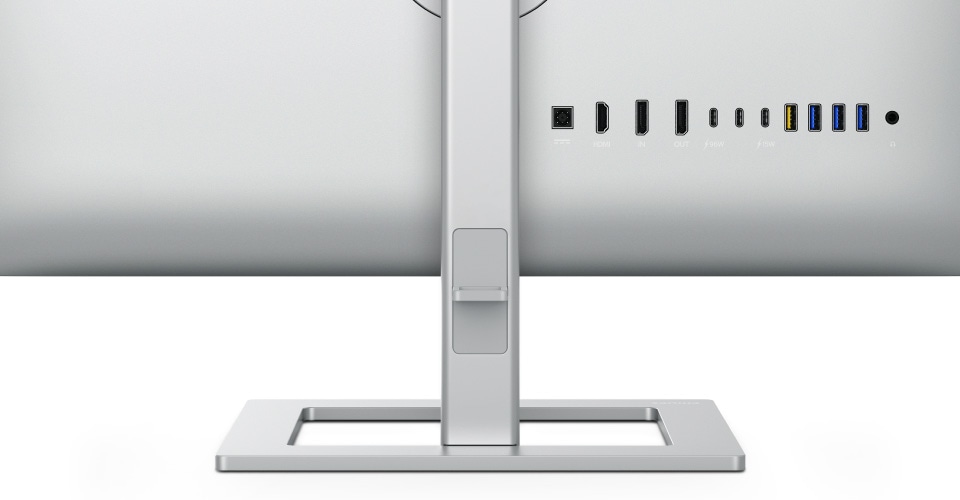What are KVM Switches and what are they doing in a monitor?
A KVM switch, short for Keyboard, Video, and Mouse switch, is traditionally a hardware device that allows users to control multiple computers using a single set of peripherals, usually on a single screen. This allows a user to do work on, for example, a PC and a laptop at the same time, with the ability to easily toggle between sources. This can benefit users in a variety of scenarios, such as those who have both a home PC and a work notebook and want to see content on the big screen from both without constantly plugging and unplugging their HDMI cable. Let’s dive more deeply into what KVM is, what it means for your workspace, and how it has developed into a built-in function.

What is a KVM switch used for?
Traditionally, KVM switches were an external mechanism that was used to switch between different PCs without having to swap out cables or use multiple sets of peripherals constantly. This saved time, increased productivity, and streamlined workflow; making it an essential tool for professionals. Nowadays, the modern KVM switch is used for the same purpose, but it is built-in into selective premium monitors.
How does a KVM switch work on a monitor?

When it comes to using a KVM switch on a monitor, the device allows users to switch between different computers by simply pressing a button or using a hotkey combination on their keyboard. The KVM switch is connected to the monitor through a video cable, enabling it to display the output from the selected computer. Some KVM switches can support multiple monitors, allowing users to connect multiple displays and switch between computers on different screens.
Which monitors have a built-in KVM switch?
In our Philips premium monitor line, we offer multiple monitors with built-in KVM switches: The feature on these monitors, named MultiClient Integrated KVM, works with two different PCs and can be controlled with a simple, convenient button. Check out our latest model with MultiClient Integrated KVM designed for the creators and designers, the Philips 27E2F7901.
What to look for when buying a KVM switch?
When it comes to buying a KVM switch (built-in or not), there are
several factors to consider. Below you will find these factors listed:
Can I use a KVM switch with dual monitors?
Yes, it is possible to use a KVM switch with dual monitors, but it depends on the specific model of the switch and the type of monitor you are using. Most mainstream KVM switches support between one and three monitors.
Can a KVM switch work with a laptop?
Yes, a KVM switch can work with a laptop, and most new models are optimized for this. Overall, using a KVM switch with a laptop can be a convenient and efficient way to manage multiple computers from a single set of peripherals, thereby allowing users to maximize productivity and minimize clutter.

What is the difference between a docking station and a KVM switch?
While docking stations and KVM switches may seem similar in functionality, they serve very different purposes. A docking station is a device that connects a laptop or Most Philips business line monitors offer integrated USB-C docking in addition to MultiClient Integrated KVM. The USB-C docking replaces old, traditional docking stations. With this integrated feature, professionals can charge their laptop(s), transfer data rapidly, and easily connect to the internet via USB-C single cable solution.
mobile device to a desktop setup, providing additional ports and functionality, including charging, external displays, and Ethernet connectivity. It transforms a laptop into a desktop computer by providing all the necessary peripherals and
connections.
How is KVM switch powered?
Depending ontheir design and specifications, KVM switches can get power from various sources. Some KVM switches draw power from the computers they are connected to. To give an example, they can use a USB connection for power and data transfer. In this case, the KVM switch relies on the power output from the connected devices, such as the Philips USB-C docking solution. In conclusion, a KVM switch is a device that allows users to control multiple computers or devices from a single set of peripherals, including a keyboard, video, and mouse, but it has recently developed into a virtual business solution. KVM switches provide a convenient and efficient way to manage multiple computers, which is an increasingly useful feature in homes and offices, where devices have continually proliferated.
-
- P Line
- 49 (48.8" / 124 cm diag.)
- 5120 x 1440 (Dual QHD)
-
Curved UltraWide LCD Monitor with USB-C
346B1C/27
- B Line
- 34" (86.36 cm)
- 3440 x 1440 (WQHD)




